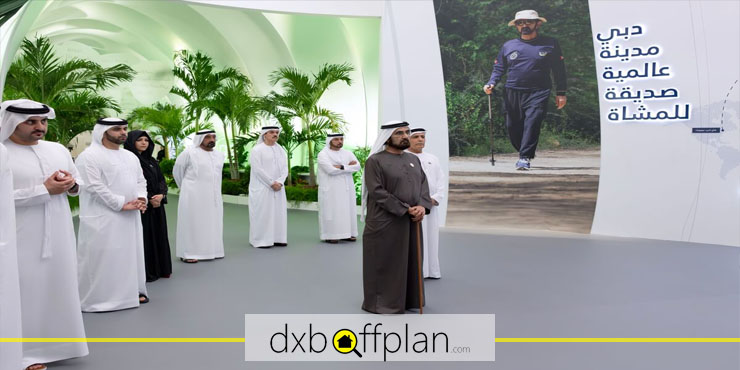محمد بن راشد دبی را به شهری برای پیادهروی تبدیل میکند
اعلیحضرت شیخ محمد بن راشد آل مکتوم، معاون رئیس و نخستوزیر امارات متحده عربی و حاکم دبی، طرح جامع «دبی واک» (Dubai Walk Master Plan) را تایید کرد. این طرح آیندهنگر با هدف تبدیل دبی به شهری دوستدار عابران پیاده طراحی شده است. در این مراسم، اعلیحضرت شیخ مکتوم بن محمد بن راشد آل مکتوم، معاون نخستوزیر و وزیر دارایی امارات و معاون اول حاکم دبی نیز حضور داشت.
طرح جامع «دبی واک» بر دسترسی آسان، ایمنی و تجربهای لذتبخش از پیادهروی تاکید دارد و شبکهای یکپارچه و منحصربهفرد از مسیرهای پیادهروی با مسیرهای آزاد و فضای سبز گسترده ایجاد میکند.
چشمانداز و اهداف طرح
شیخ محمد بن راشد آل مکتوم اعلام کردند که ارتقای کیفیت زندگی در دبی همچنان یکی از اهداف کلیدی چشمانداز استراتژیک این امارت است. وی تاکید کرد که ایجاد زیرساختهای خلاقانه و مقصدی منحصربهفرد، جایگاه جهانی دبی را تقویت کرده و آن را به برترین شهر برای زندگی، کار و بازدید تبدیل میکند.
ایشان فرمودند:
«ما طرح جامع دبی واک را تایید کردهایم. این طرح شامل شبکهای ۶,۵۰۰ کیلومتری از مسیرهای پیادهروی مدرن در ۱۶۰ منطقه امارت است. برنامهریزی شده که ۳,۳۰۰ کیلومتر مسیر جدید ساخته شود و ۲,۳۰۰ کیلومتر مسیر موجود تا سال ۲۰۴۰ بازسازی گردد. علاوه بر این، بیش از ۹۰۰ کیلومتر مسیر برای پس از سال ۲۰۴۰ برنامهریزی شده است. این طرح شامل توسعه ۱۱۰ پل و زیرگذر برای عابران پیاده نیز میشود. هدف این برنامه بلندپروازانه افزایش استفاده از پیادهروی و حملونقل سبک از ۱۳ درصد به ۲۵ درصد تا سال ۲۰۴۰ است.»
ایشان افزودند:
«دبی شهری آیندهنگر است که به ایجاد محیطی شهری سالم و شاداب متعهد است. طرح جامع دبی واک سبک زندگی فعال را ترویج داده و فرصتهای ورزشی برای همگان فراهم میکند. این چشمانداز پیادهروی را به بخشی مرکزی از فرهنگ و زندگی روزمره ما تبدیل میکند. این طرح دبی را به یکی از سالمترین و پایدارترین شهرهای جهان بدل خواهد کرد.»
جزئیات طرح
در ادامه به جزئیات این طرح جذاب میپردازیم:
فازهای اجرای طرح:
این طرح در سه مرحله، از سال ۲۰۲۵ تا ۲۰۴۰ اجرا خواهد شد. فاز پایلوت از ۲۰۲۵ تا ۲۰۲۷ شامل ایجاد ۱۷ کیلومتر مسیر در دو مسیر کلیدی است:
- مسیر تاریخی الراس: مسیر ۱۵ کیلومتری که تاریخ امارت را به نمایش میگذارد و شامل ۵ کیلومتر مسیر در کنار آبراه بازسازیشده با ۲۵ میدان عمومی سبز، نمایشگاههای هنری و نقاط سایهدار است.
- پروژه «حلقه آینده» در موزه آینده: این مسیر مرتفع ۲ کیلومتری که عرض آن بین ۶ تا ۱۵ متر است، موزه آینده دبی را به مراکز مهمی مانند مرکز تجارت جهانی، برجهای امارات، مرکز مالی بینالمللی دبی و ایستگاههای مترو متصل میکند.
اتصال مناطق و تسهیلات
این طرح بر بهبود اتصال مناطق شهری از طریق توسعه زیرساختهای پیادهروی، ساخت ۱۱۰ پل و زیرگذر و ارتقای مسیرهای موجود تمرکز دارد. پروژههای اصلی شامل:
- پلهایی در جاده اتحاد که النهده و الممزر را متصل میکنند.
- جاده طرابلس برای اتصال الورقاء و مردف.
- جاده الخوانیج برای اتصال مشرف و الخوانیج.
- جاده دبی-العین برای اتصال دبی سیلیکون اوسیس و دبیلند.
طراحی نوآورانه مسیرها
طرح دبی واک شامل مسیرهای طراحیشده برای بازتاب هویت هر منطقه است. این مسیرها با امکانات زیر تجهیز خواهند شد و به شبکه حمل و نقل عمومی شهر دبی متصل خواهند شد:
- فضای سبز: مناطق سایهدار، سیستمهای خنککننده و صفحهنمایشهای دیجیتال تعاملی.
- امکانات رفاهی: نمایشگاههای هنری، تجهیزات ورزشی، اتاقهای استراحت و فضاهای تجاری.
- ایمنی و دسترسی: تابلوهای راهنما، نورپردازی، و تعامل با سیستمهای هوشمند برای اولویتبخشی به ایمنی و راحتی.
مشارکت هوشمند و فرهنگسازی
یک اپلیکیشن هوشمند نیز راهاندازی خواهد شد که کاربران را قادر میسازد مسافتهای پیادهروی، مدتزمان، مسیرها و امتیازات خود را دنبال کنند. این اپلیکیشن اطلاعات مربوط به ویژگیهای مسیر، رویدادهای نزدیک و امتیازات قابلتبدیل را ارائه خواهد داد.
نتیجه گیری:
طرح جامع «دبی واک» نشاندهنده تعهد دبی به بهبود کیفیت زندگی، توسعه پایدار و ارتقای جایگاه خود به عنوان یکی از پیشرو ترین شهرهای جهان است. با اجرای این طرح، دبی گامی بلند در جهت تبدیل شدن به شهری پیادهمحور و دوستدار محیط زیست برمیدارد.









